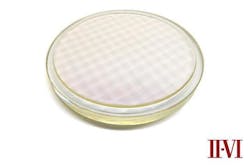Product focus: II-VI introduces freeform high-power beam-shaping laser optics for fiber and direct-diode laser applications
II‐VI (Saxonburg, PA; NASDAQ:IIVI) has unveiled a line of freeform beam-shaping laser optics for high-power fiber and direct-diode laser materials-processing applications.
The use of lasers in materials processing provides a degree of freedom beyond that of other processing methods, and that is the high brightness and coherent of the heat source (the laser spot). As a result, laser processing heads with engineered beam geometries tailored to the application can optimize process efficiency, and minimize equipment cost and size, by putting the light only where it's needed. II-VI's freeform diamond turning capabilities allow the production of custom high-power laser optics with freeform surfaces for custom beam shaping used in advanced laser processing.
Bessel-focus lenses
"II-VI is leveraging its deep expertise in freeform nanotechnology surfacing techniques to offer a nearly limitless number of custom design options to optimize laser-based materials processing tasks," said John Ryan, the company's VP of sales. "Our Bessel-focus lenses in particular enable our customers to engineer beams with elongated depth of focus that greatly improve the efficiency of their laser-processing heads."
Beam-shaping laser optics produced by II-VI include Bessel-focus lenses, faceted integrators, vortex lenses, flat-top converters, biconic lenses, axicons, and dual-focus lenses. II-VI also offers debris windows as well as capabilities in optical design, fabrication, thin film coatings, and metrology. For more info, see www.ii-vi.com.
II-VI will be at SPIE Photonics West (San Francisco, CA; Jan. 30- Feb. 1, 2018) at booth # 1230.
About the Author
John Wallace
Senior Technical Editor (1998-2022)
John Wallace was with Laser Focus World for nearly 25 years, retiring in late June 2022. He obtained a bachelor's degree in mechanical engineering and physics at Rutgers University and a master's in optical engineering at the University of Rochester. Before becoming an editor, John worked as an engineer at RCA, Exxon, Eastman Kodak, and GCA Corporation.

